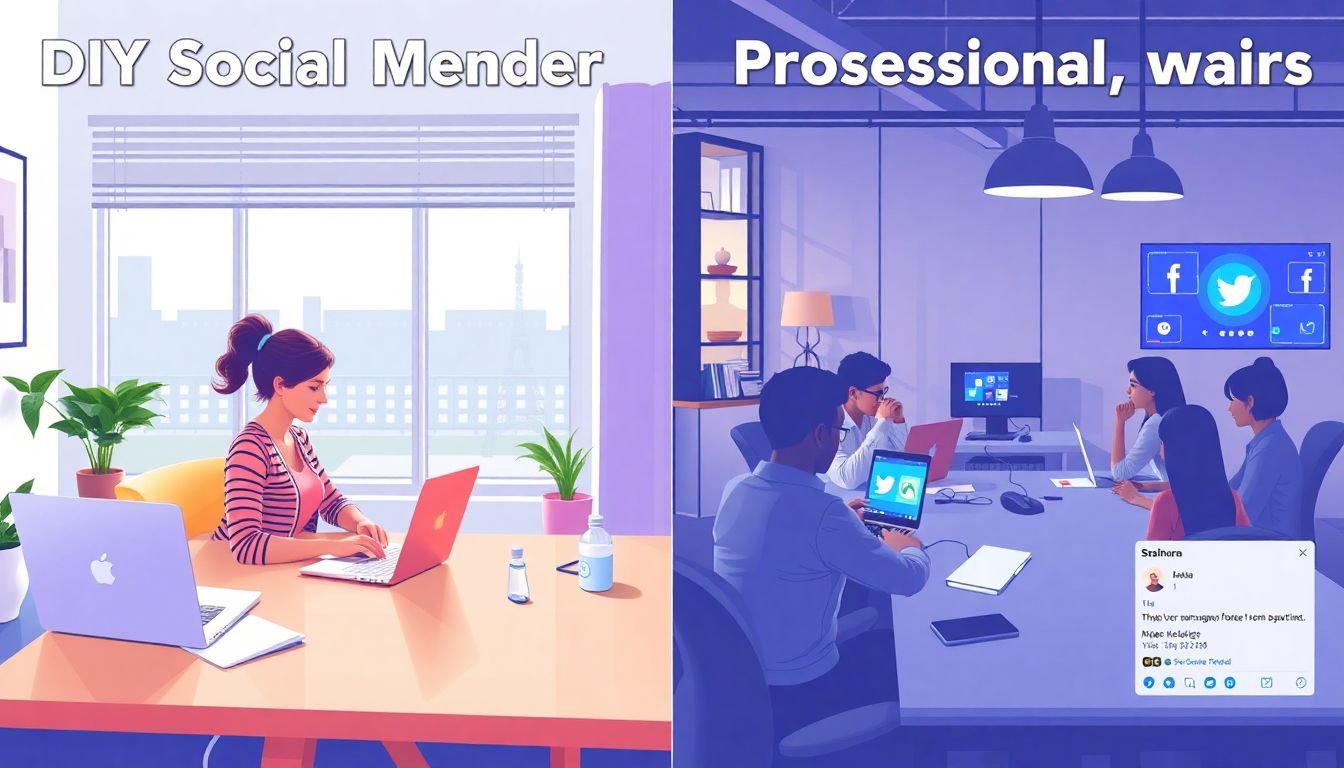
Table of Contents
In the digital age, social media has become an indispensable tool for businesses, large and small, to connect with their audience, promote their brand, and drive sales. But when it comes to managing these platforms, a crucial question arises: should you take the DIY approach or hire a professional? Both options have their merits, but which one is the most cost-effective in the long run? Let’s dive into this conundrum and explore the ins and outs of DIY vs. professional social media management.
Did you know that there are over 4.2 billion active social media users worldwide, and this number is growing by the day? With such a vast audience at your fingertips, it’s no surprise that businesses are eager to harness the power of social media. But with great opportunity comes great responsibility. Managing social media accounts requires a significant time investment, a deep understanding of your audience, and a knack for creating engaging content. So, the question remains: do you have the time, skills, and resources to manage your social media in-house, or would you be better off outsourcing to a professional?
Agree: We can all agree that social media is a powerful tool that, when used effectively, can significantly boost your business’s growth and success. But we also agree that managing it can be a daunting task. It’s like trying to navigate a maze blindfolded
- you might eventually find your way out, but it’s going to take a lot of time and effort.
Promise: In this article, we promise to shed some light on that maze. We’ll explore the pros and cons of both DIY and professional social media management, helping you understand which option is more cost-effective for your business in the long run. We’ll delve into the time, skills, and resources required for each approach, and provide real-life examples to illustrate our points.
Preview: By the end of this article, you’ll have a clear understanding of what each approach entails, and you’ll be equipped to make an informed decision based on your business’s unique needs and budget. We’ll also provide some tips on how to make the most of your chosen approach, ensuring that your social media strategy is as effective and cost-efficient as possible. So, buckle up and get ready to navigate the social media management maze with confidence and clarity!
Navigating the Spectrum of Social Media Management: DIY to Professional Services
In the dynamic landscape of digital communication, social media management has evolved into a multifaceted role, offering a spectrum of approaches that cater to diverse needs and resources. At one end lies the DIY approach, where businesses and individuals take the reins, crafting their online presence with a hands-on, personal touch. This route is often chosen for its cost-effectiveness and the intimate understanding it provides of one’s audience. It’s like tending to a garden, where every seed sown and every weed pulled is a conscious decision made by the gardener themselves. However, as the garden grows, so too does the workload, and maintaining a thriving online presence can become a full-time job in itself. This is where professional services come into play, offering expertise, time-saving strategies, and a fresh perspective. They are the master gardeners, equipped with advanced tools and years of experience, capable of transforming even the most overgrown social media platforms into flourishing, productive spaces. Between these two extremes lie various shades of grey, from part-time assistance to hybrid models that blend in-house efforts with professional support. Navigating this spectrum involves weighing the value of personal touch against the benefits of expert guidance, and understanding that the best approach is often a fluid one, evolving as the needs of your online presence grow and change.

Understanding the DIY Approach
Embarking on the DIY approach to managing social media accounts is a journey that’s equal parts empowering and challenging. Let’s break down the key aspects, advantages, and potential pitfalls to help you navigate this digital landscape. Advantages: The DIY Advantage
-
Cost-Effective:
- DIY management eliminates the need for expensive agency fees, allowing you to allocate your budget elsewhere.
Personal Touch:
- You understand your brand’s voice and values best. DIY management ensures your content remains authentic and consistent.
Flexibility:
- You’re the boss. DIY management allows you to respond to trends and changes in real-time.
Disadvantages: The DIY Dilemma However, it’s not all sunshine and roses. DIY management comes with its own set of challenges.
Time Commitment:
- Social media management is a full-time job. It requires consistent posting, engagement, and analysis. Are you ready to commit the time?
Learning Curve:
- Social media is a dynamic beast. Algorithms change, trends shift, and new platforms emerge. Are you prepared to keep learning?
Potential Pitfalls:
- Without professional guidance, you might fall into common traps like over-posting, under-engaging, or worse, posting inappropriate content.
Key Aspects: The DIY Toolkit To succeed in DIY social media management, you’ll need to master these key aspects:
Content Creation:
- Regular, engaging, and on-brand content is the lifeblood of your social media presence.
Engagement:
- Respond to comments, messages, and mentions. Build relationships with your audience.
Analysis:
Use analytics tools to understand your audience, track your performance, and refine your strategy.
So, are you ready to take the DIY plunge? It’s a rewarding journey, but it’s not for the faint-hearted. Weigh the pros and cons, and remember, it’s always okay to ask for help when you need it.

The Professional Edge
In today’s digital age, social media has become an indispensable tool for businesses, offering unparalleled opportunities to connect with customers, build brand awareness, and drive sales. However, managing social media platforms effectively can be a complex task, requiring a delicate balance of creativity, technical know-how, and strategic planning. This is where professional social media management services come into play, providing businesses with a distinct professional edge.
The primary advantage of hiring professional services lies in their expertise. These teams comprise seasoned social media specialists who possess an in-depth understanding of various platforms, their algorithms, and best practices. They stay updated with the latest trends and changes in the social media landscape, ensuring your business remains relevant and visible. Moreover, they bring a fresh perspective to your brand, helping you see your business through the eyes of your audience.
Professional services also bring with them a wealth of resources. They have access to advanced tools and analytics platforms that provide valuable insights into your audience, their behavior, and the performance of your campaigns. These tools enable data-driven decision making, allowing you to refine your strategies and maximize your return on investment.
Another significant benefit is the ability to scale campaigns. Professional services have the capacity to handle multiple platforms and campaigns simultaneously, ensuring consistent and timely posting. They can quickly adapt to changes in your business or market, scaling up or down your social media presence as needed. This scalability is particularly beneficial for businesses experiencing rapid growth or those preparing to launch new products or services.
In conclusion, hiring professional social media management services can provide your business with a significant professional edge. By leveraging their expertise, resources, and ability to scale campaigns, you can enhance your online presence, engage your audience more effectively, and ultimately, drive business growth.
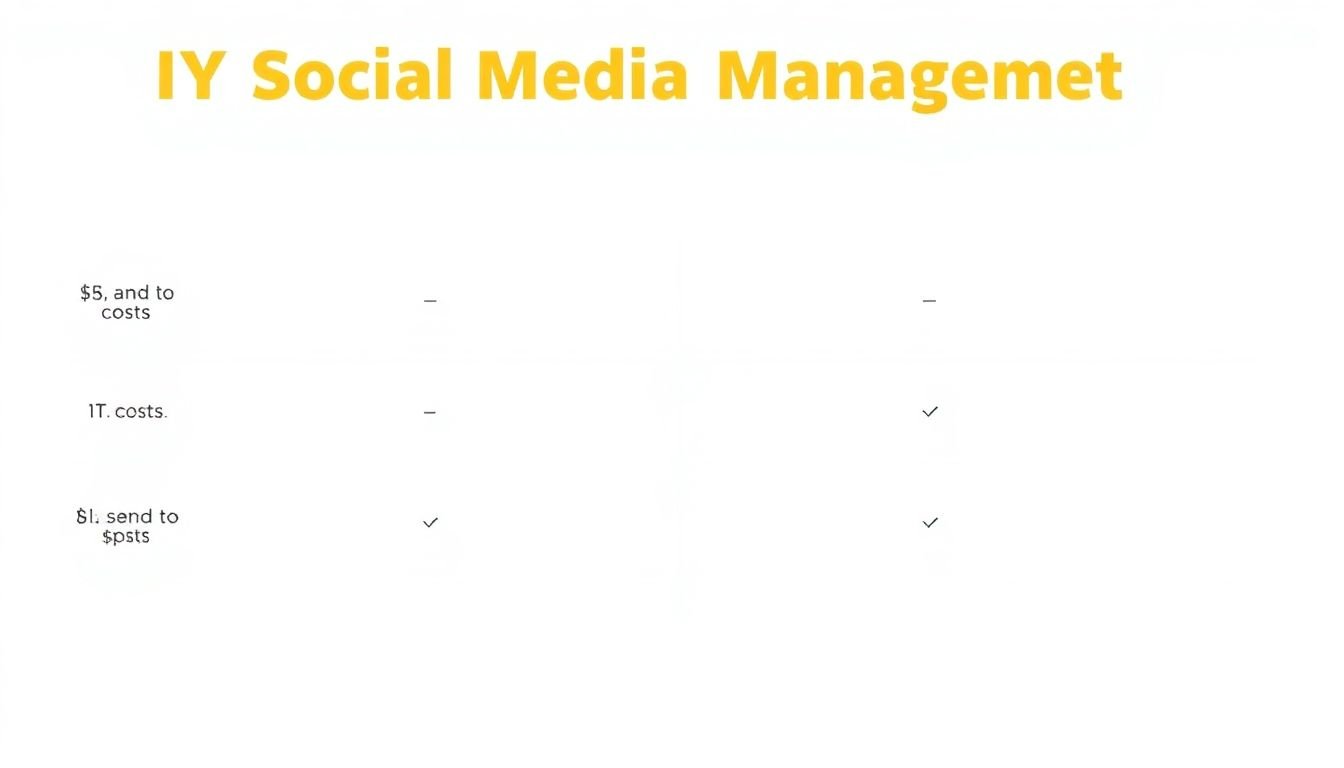
Cost-Benefit Analysis: DIY
Embarking on a DIY social media management journey is akin to navigating a dynamic, digital landscape, where the terrain is ever-changing, and the view is always evolving. Let’s break down the costs associated with this adventure, from the initial setup to the ongoing maintenance, and explore the potential returns that make this endeavor a worthwhile investment of your time and resources.
The first cost that comes into play is the software you’ll need to manage your social media platforms effectively. This includes tools for scheduling posts, analyzing performance, and engaging with your audience. While there are free options available, investing in robust software like Hootsuite, Buffer, or Sprout Social can significantly enhance your efficiency and provide valuable insights. The cost of these tools typically ranges from $10 to $100 per month, depending on the features and the number of platforms you’re managing.
Next, let’s consider the time cost. DIY social media management requires a significant time investment. You’ll need to create engaging content, schedule posts, respond to comments, and analyze your performance. According to a study by Social Media Examiner, small businesses spend an average of 6 hours per week on social media. That’s 312 hours per year, or roughly 7.8 weeks of full-time work. While this time is an investment in your business, it’s crucial to consider what else you could be doing with those hours, such as focusing on core business activities or taking a well-deserved vacation.
Opportunity costs are the gains you could have made by using your time and resources in the best alternative way. For instance, you might be able to hire a professional social media manager for the time you’re spending on DIY management. According to Glassdoor, the average salary for a social media manager in the U.S. is around $50,000 per year. However, this cost is often offset by the potential returns on investment.
Now, let’s talk about those potential returns. Effective social media management can lead to increased brand awareness, improved customer engagement, and even direct sales. According to a study by Pew Research Center, 68% of Americans use Facebook, and 70% of those users have discovered new products or services on the platform. By consistently creating and sharing valuable content, you can tap into this vast market and grow your business.
Moreover, social media management can provide valuable insights into your audience and market trends. Tools like Google Analytics and social media analytics can help you understand what’s working and what’s not, allowing you to refine your strategy and improve your results over time.
In conclusion, DIY social media management comes with its own set of costs, from the software you’ll need to the time you’ll invest. However, these costs can be offset by the potential returns, including increased brand awareness, improved customer engagement, and valuable market insights. By understanding these costs and benefits, you can make an informed decision about whether DIY social media management is the right choice for your business.
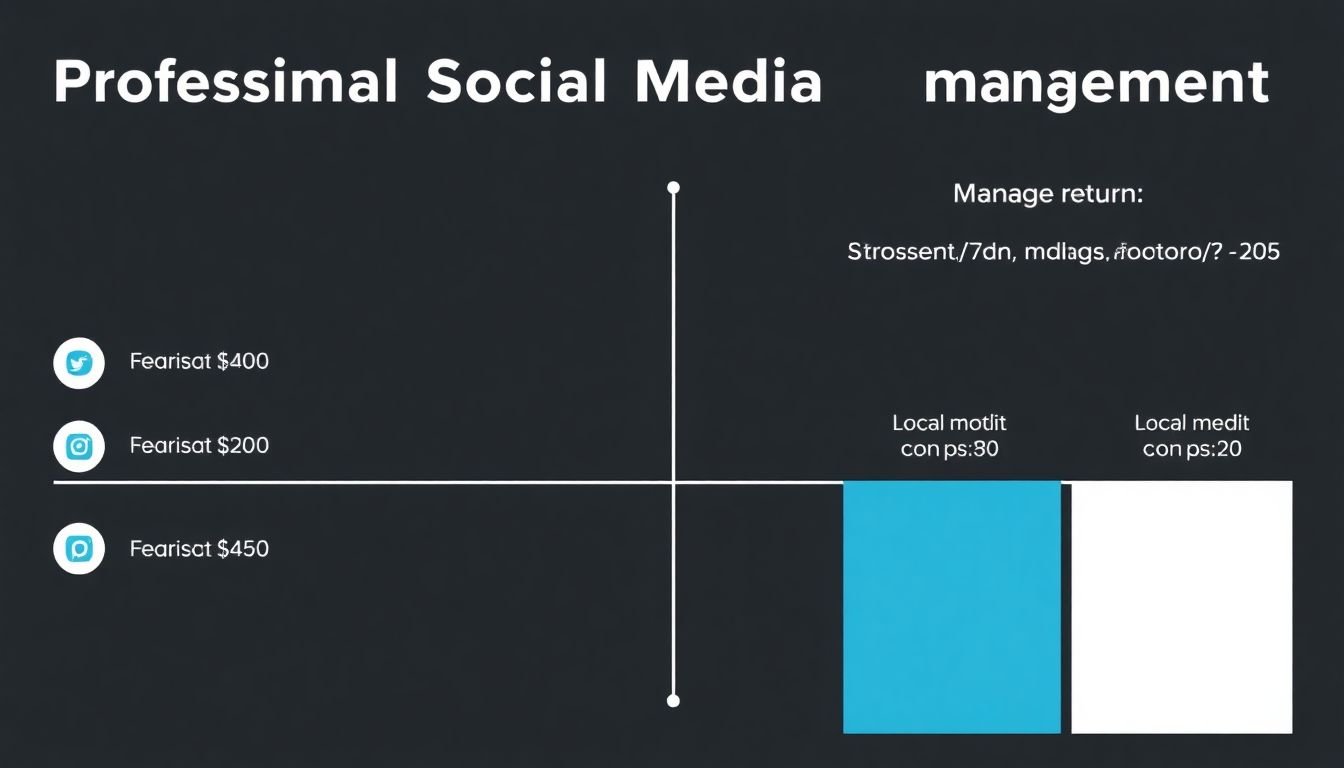
Cost-Benefit Analysis: Professional
In the dynamic world of digital marketing, professional social media management services have emerged as a critical investment for businesses seeking to maximize their online presence. These services, offered by specialized agencies or freelancers, come with a variety of pricing structures, ranging from hourly rates to monthly retainers, and even performance-based models. The cost can vary significantly, depending on factors such as the size of the business, the scope of work, and the level of expertise required.
When considering the cost of professional social media management, it’s essential to look beyond the immediate expense and evaluate the potential return on investment (ROI). This involves examining several key performance indicators (KPIs) that can translate into tangible business benefits. One of the most significant potential ROI factors is improved engagement. Professional social media managers are equipped with tools and strategies to increase user interaction with your brand, such as likes, shares, comments, and reviews. This not only boosts your brand’s visibility but also fosters customer loyalty and advocacy.
Another crucial aspect to consider is the potential increase in reach. Social media platforms are vast networks with billions of users, and a well-executed social media strategy can significantly expand your brand’s reach. Professional services employ techniques like targeted advertising, influencer partnerships, and viral content creation to expose your brand to a broader audience. This increased reach can lead to more website traffic, email subscribers, and ultimately, more customers.
Lastly, the potential for improved conversions is a significant factor in the ROI equation. Professional social media management services can help optimize your social media profiles to drive traffic to your website and convert visitors into customers. This can involve creating compelling calls-to-action, optimizing landing pages, and leveraging social proof to build trust and encourage conversions. By improving your conversion rate, even a modest increase in traffic can result in a substantial boost in sales and revenue.
In conclusion, while the cost of professional social media management services may seem high, the potential ROI can be substantial. By improving engagement, increasing reach, and driving conversions, these services can generate significant value for your business. However, it’s crucial to approach this analysis with a critical eye, ensuring that the services you choose align with your business goals and that the potential benefits outweigh the costs.
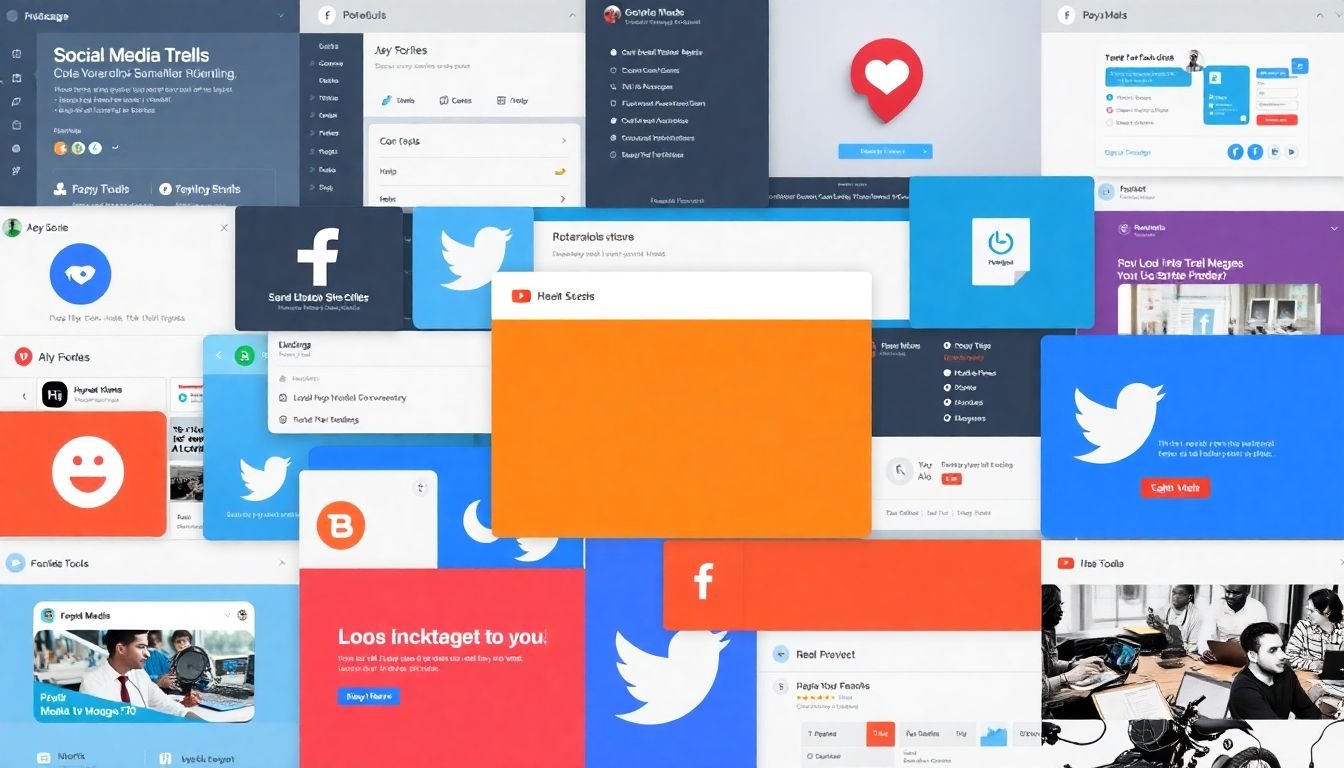
DIY Tools and Platforms
In the dynamic world of digital marketing, managing social media platforms can be a daunting task. However, with the advent of DIY tools and platforms, this challenge has been transformed into an opportunity for businesses of all sizes to engage with their audience effectively. Let’s delve into some of the most popular DIY social media management tools and platforms, exploring their unique features, pricing structures, and ease of use.
The first tool that deserves a mention is Hootsuite, a robust platform that supports a wide array of social networks. It offers a user-friendly interface with features like scheduling posts, analytics, and team management. Hootsuite’s pricing is tiered, starting from a free plan, followed by Professional ($29/month), Team ($129/month), and Business ($520/month) plans.
Another notable tool is Buffer, known for its intuitive design and powerful publishing features. It allows users to schedule posts, analyze performance, and manage engagement. Buffer’s pricing is straightforward, with plans starting at $15/month for the ‘Publish’ plan, $65/month for ‘Analyze’, and $80/month for ‘Re-engage’.
For those seeking an all-in-one marketing platform, MeetEdgar is an excellent choice. It offers a unique ‘Categories’ feature for automated scheduling, along with analytics and engagement tracking. MeetEdgar’s pricing is simple, with a single plan at $49/month, which includes up to 25 social media profiles.
Lastly, let’s consider Zapier, a unique tool that automates workflows between different apps, including social media platforms. It offers a free plan, with paid plans starting at $19.99/month for ‘Starter’, $49/month for ‘Professional’, and $149/month for ‘Team’.
Each of these tools offers a free trial, allowing users to explore their features before committing to a plan. When choosing a DIY social media management tool, consider your business’s specific needs, the platforms you use, and your budget. After all, the right tool can significantly enhance your social media strategy, saving you time and increasing your online presence.
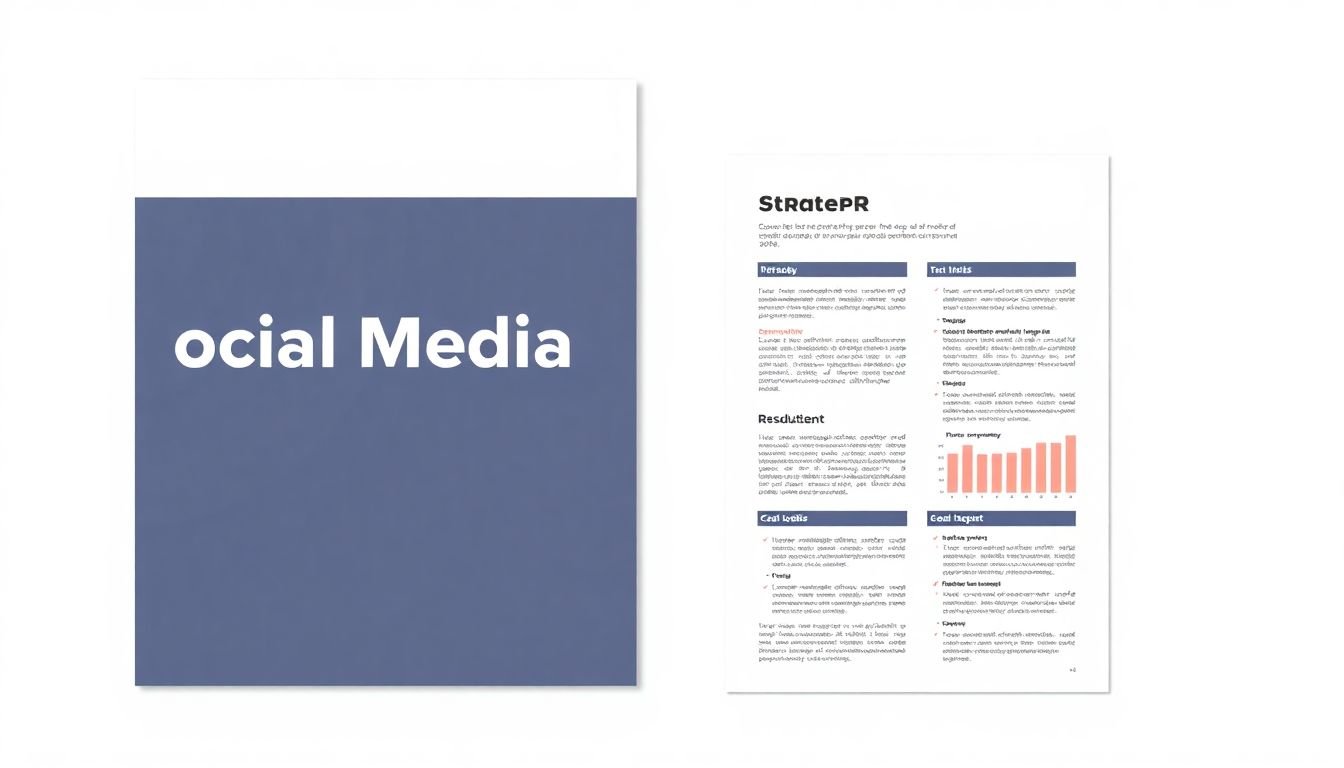
Professional Services: What to Expect
When engaging with a professional social media management agency, clients can expect a comprehensive suite of services designed to elevate their online presence and drive meaningful engagement. The journey begins with strategy development, a critical phase where the agency delves into understanding the client’s brand, target audience, and business objectives. This process involves market research, competitive analysis, and the creation of a tailored social media strategy that aligns with the client’s overall marketing goals.
The next step, content creation, is where the agency’s creativity and storytelling prowess come to the fore. They craft compelling, on-brand content that resonates with the target audience, ensuring a consistent voice and visual style across all platforms. This includes designing eye-catching graphics, writing persuasive captions, and even creating video content to keep the audience engaged and informed.
Once the content is published, the agency doesn’t simply hit ‘post’ and move on. Instead, they monitor the performance of each piece of content through analytics. This involves tracking key metrics such as reach, engagement, clicks, and conversions. By analyzing this data, the agency can gain insights into what’s working and what’s not, allowing them to refine their strategy and improve future content.
Finally, the agency provides regular, detailed reports to the client. These reports don’t just list numbers; they tell a story. They explain the trends, highlight the successes, and suggest areas for improvement. The reports are designed to be accessible and actionable, ensuring the client is always in the loop and can make informed decisions about their social media strategy. In essence, working with a professional social media management agency is about more than just outsourcing a task; it’s about partnering with experts who can help you navigate the complex world of social media and achieve your business goals.

Hybrid Approaches: The Best of Both Worlds
In the dynamic landscape of modern business, the age-old debate between DIY and professional services has given way to a more nuanced approach: hybrid solutions. These approaches, much like the mythical centaur, combine the strengths of both worlds, offering the best of both flexibility and expertise.
At the heart of hybrid approaches lies the idea of complementing in-house capabilities with external support. This could manifest in various ways, such as hiring a consultant to guide your team through a complex project, or engaging a training provider to upskill your employees while your HR team handles the logistics.
One of the primary advantages of hybrid approaches is the cost-effectiveness they offer. By leveraging your existing resources and only bringing in external help when needed, you can avoid the high costs associated with full-time professional services. Moreover, this approach fosters a culture of learning and growth within your team, as they gain insights from both internal and external experts.
However, hybrid approaches are not without their challenges. One key issue is ensuring seamless integration between your in-house team and the external provider. This requires clear communication, well-defined roles, and a shared understanding of the project’s goals. Another challenge is maintaining the balance between independence and dependence on the external provider. It’s a delicate dance, but with careful management, it can lead to a powerful synergy.
In essence, hybrid approaches offer a middle ground that allows businesses to maximize their resources, minimize costs, and foster a culture of continuous learning. They are not a one-size-fits-all solution, but rather a tailored approach that can be adapted to suit the unique needs and circumstances of each organization. So, why not explore this fascinating territory and reap the benefits of having your cake and eating it too?

Case Studies: Real-World Examples
In the dynamic world of digital marketing, social media management has emerged as a critical success factor for businesses of all sizes. To illustrate the effectiveness of both DIY and professional social media management strategies, let’s delve into two compelling case studies.
The first case study examines the journey of a small, local bakery, ‘Bun in the Oven’, which opted for a DIY approach. The bakery’s owner, a tech-savvy individual, decided to manage their social media presence using free tools and platforms. They started by creating engaging content around their freshly baked goods, behind-the-scenes glimpses, and customer testimonials. Within six months, their Instagram following grew by 300%, leading to a 25% increase in foot traffic and a 15% boost in online sales. The key lessons learned here are the power of authenticity, consistency, and understanding your audience.
On the other hand, ‘GreenLeaf’, a multinational corporation specializing in eco-friendly products, chose to hire a professional social media management team. With a vast array of products and a global audience, GreenLeaf needed a strategic approach. The professional team implemented a multi-platform strategy, including targeted ads, influencer partnerships, and user-generated content campaigns. The results were astounding: a 45% increase in brand awareness, a 30% boost in sales, and a significant improvement in customer engagement. The lessons learned here highlight the importance of a well-structured strategy, expert execution, and the ability to adapt to diverse audiences.
Both case studies demonstrate that successful social media management is not about the size of your budget or the tools you use, but rather about understanding your audience, staying consistent, and being willing to adapt and learn. Whether you choose a DIY or professional approach, the key lies in creating a strategy that resonates with your unique business needs and goals.
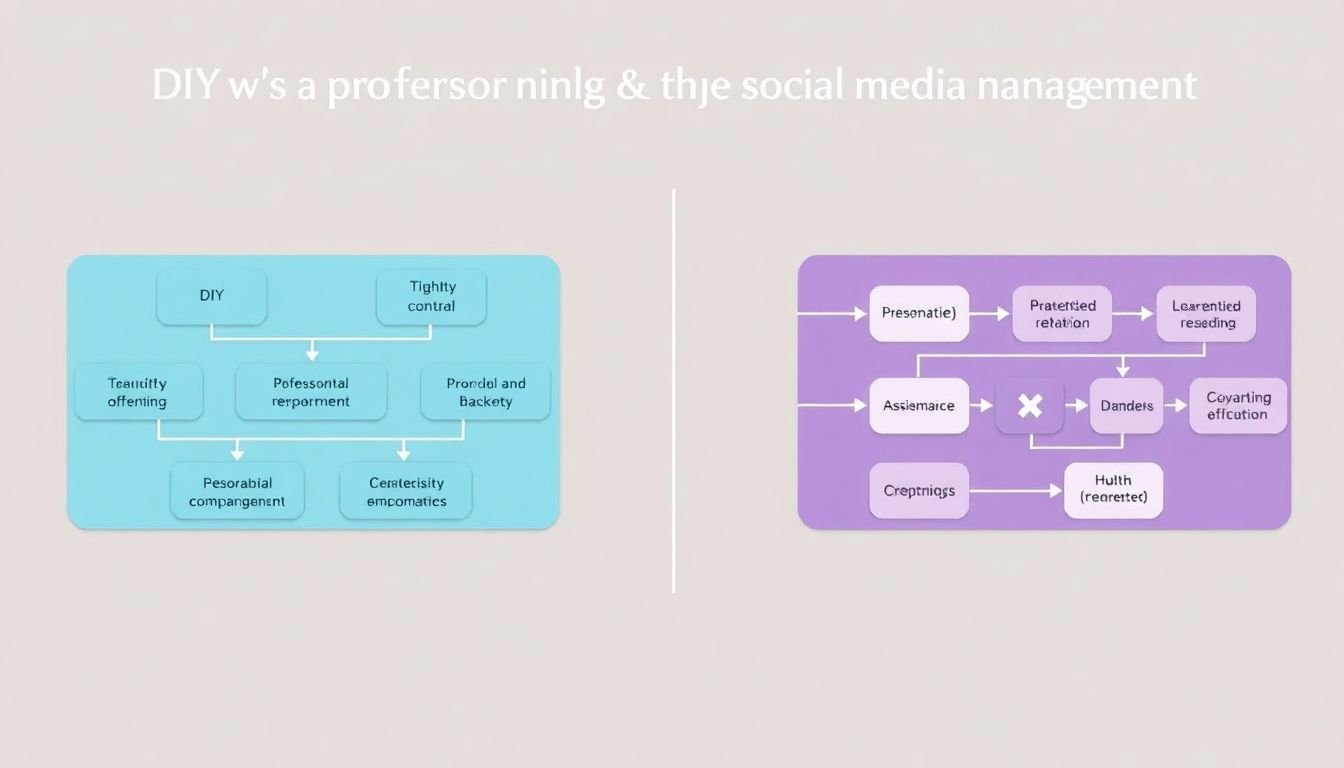
Making the Right Choice for Your Business
When it comes to social media management, businesses often grapple with the decision between handling it in-house (DIY) and hiring a professional. The right choice depends on several factors, including your business size, budget, and goals. Let’s break down these aspects to help you make an informed decision. First, consider your business size. For small businesses or startups with limited resources, DIY social media management might be the way to go. It allows you to maintain a personal touch, understand your audience intimately, and control costs. However, it requires time and effort, which could be better spent on core business activities. Here are some steps to help you manage social media on your own:
- Set clear goals and strategies.
- Create a content calendar to plan and schedule posts.
- Engage with your audience consistently.
- Monitor and analyze performance using free tools like Google Analytics.
On the other hand, larger businesses with more complex needs might benefit from professional social media management. Professionals bring expertise, time-saving tools, and often, a larger team dedicated to your brand. They can help you reach a wider audience, improve engagement, and drive more conversions. However, they come at a cost, which could be significant for small businesses. Budget is another crucial factor. DIY is cost-effective, but it might not be the best use of your time. If you can afford it, investing in a professional could yield better results and free up your time to focus on other aspects of your business. Lastly, consider your goals. If you’re looking to build a strong online presence, drive traffic to your website, or increase sales, a professional might be the better choice. They can help you create targeted campaigns, optimize your content for different platforms, and track key performance indicators (KPIs). Remember, your needs may change over time. What works today might not tomorrow. It’s essential to reassess your social media strategy periodically. Your business might grow, your audience might change, or new platforms might emerge. Be prepared to adapt your approach accordingly. In conclusion, there’s no one-size-fits-all answer to the DIY vs. professional social media management debate. Both have their pros and cons. The key is to understand your business, your budget, and your goals, and make a choice that aligns with them. And don’t forget, it’s okay to start small and scale up as your business grows.
FAQ
What exactly is DIY social media management?
What are the key benefits of managing social media in-house?
How can I get started with DIY social media management?
- Identify your target audience and where they’re most active online.
- Choose the right social media platforms for your business.
- Create and optimize your business profiles.
- Develop a content strategy and create a content calendar.
- Use scheduling tools to plan and automate your posts.
- Engage with your audience by responding to comments and messages.
- Regularly analyze your performance metrics to refine your strategy.
What are the potential drawbacks of DIY social media management?
When should I consider hiring a professional for social media management?
What services do professional social media managers typically offer?
- Strategy development and planning.
- Content creation and curation.
- Post scheduling and publishing.
- Engagement and community management.
- Performance analysis and reporting.
- Advertising and promotion management.
- Influencer marketing and collaborations.
They also stay updated with the latest trends and algorithms, ensuring your business stays ahead of the curve.